Street lighting refers to the mandatory elements of the improvement of residential areas, the procedure for which is regulated by the standards in force in the CIS. The main document that defines the requirements for street lighting is SNiP 23-05-95. A number of industry standards, which determine the norms for the illumination of lanes, roads, squares and parks, serve the same purposes. These departmental documents stipulate the nuances concerning the features of the illumination of specific objects, including roads and entrances to buildings.
Types of outdoor lighting
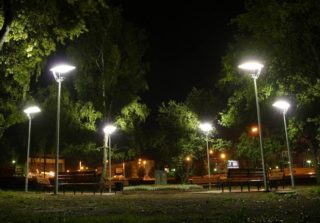
Among the various approaches to street lighting, particular attention is paid to the following types:
- decorative lighting;
- outdoor lighting of adjoining territories, areas near country houses;
- lighting design of urban areas.
The desired effect of decorative street lamps is achieved if the location of the light sources is correct. Before using them, it is important to prepare a layout scheme that takes into account the architectural features of the landscape and park areas. The essence of outdoor lighting design is to emphasize the elements of the environment and details of the objects being equipped. A characteristic feature of this approach is the ability to control the intensity and other parameters of the backlight placed on special cables.
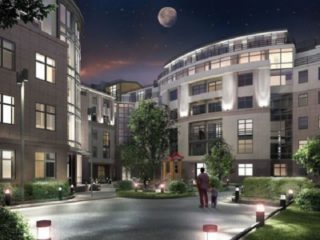
House lighting is an integral part of the planning of any construction site being commissioned. Particular attention is paid to the driveways of residential buildings that need constant lighting. When arranging it, it should be borne in mind that the street lamp on the pole should not blind the eyes.
High requirements are also imposed on street lighting of city sites, since its presence ensures the safety of living in these areas. They also relate to the architectural and design details of residential areas, which should be clearly distinguishable at night. The use of outdoor light helps in the maintenance of the following places:
- residential sector objects;
- completely open urban spaces equipped with lampposts and street lamps;
- industrial buildings;
- retail outlets and educational institutions;
- highways with heavy traffic.
To control the switching on and off of outdoor lighting, a dispatch service or automatic devices that are triggered by a sensor according to a specific schedule are provided.
Types of lighting fixtures

When organizing outdoor lighting, the following types of illuminators are traditionally used:
- powerful halogen and gas discharge lamps;
- modern mercury DRL illuminators and xenon devices;
- fluorescent lighting devices;
- induction lamps;
- modern energy saving lamps and LED illuminators.
The first three varieties have been successfully used in street lighting for many years, since they replaced the outdated arc light bulbs. But in some areas remote from the center, mainly in rural areas, mercury and sodium lamps are still successfully used. Today, they are increasingly being replaced by economical models of modern lighting fixtures - LED lamps, for example.Their use significantly improves the quality of street illumination, while simultaneously allowing you to get all kinds of effects.
Criteria for the selection of elements and control systems for outdoor lighting
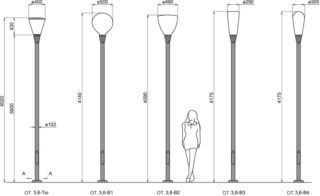
A modern outdoor lantern is not just an outdoor luminaire designed to illuminate roads or driveways. It is a reliable and reliable lighting product that can work in all weather conditions. Before choosing equipment, you will need to take a number of additional measures:
- selection of the optimal support height;
- the use of pillars that are reliable and original in shape: they can be straight, arched or patterned;
- solution of the issue with the optimal distance between the supports;
- the choice of the height of the luminaire itself: according to the requirements of the standards, it is installed at least 2.5 meters;
- the presence of a lighting control system, represented by remote blocks and standard cabinets.
Special equipment that controls lighting lanterns has a compact overall size that does not prevent it from remotely switching lighting networks.
Cabinet appearance (main characteristics)
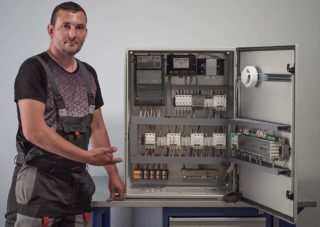
Usually the cabinet body is made of polyester. The material is classified as anti-vandal, which, moreover, is not capable of burning. The body of the cabinet controlling the lighting equipment is selected taking into account the degree of protection regulated in accordance with GOST R IEC 536-94. This classification means that it uses at least two layers of special insulation.
The main performance indicators of the control equipment represented by standard cabinets include:
- dimensions: height, length and depth;
- the material used in its manufacture;
- the level of climatic protection;
- permissible operating temperature limit.
Weight is also taken into account when choosing a control device suitable for specific conditions.
Varieties of cabinets
Various samples of equipment of this class differ in the level of functionality, which allows them to be used for both narrowly targeted and universal purposes. In addition, they differ in the way they control the lighting units:
- only local;
- automatic or manual;
- remote.
The remote control method presupposes the presence of a special dispatching point that allows you to control the entire workflow.
Outdoor lighting in country houses
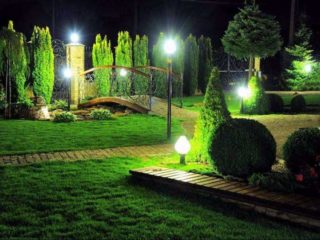
Special lights for summer cottages are mounted in compliance with the following requirements:
- Care must be taken to ensure that no shadows from nearby buildings or trees fall on the facade of the house, which gives the building an inhospitable look.
- Flashlights shouldn't shine too much; it is best to use diffused light.
- Experts advise making the light as even as possible.
The sources are installed so that the light from them falls not only on the house, but also on the nearby vegetation (bushes and trees), as well as garden paths.
Preference is given to LED home lights, which provide a number of advantages:
- profitability;
- the ability to use a backup battery in case of a power outage;
- increased reliability and convenience of obtaining scattered light.
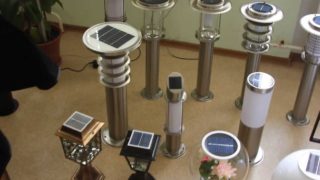
To this should be added the high intensity and significant angle of coverage.
Before connecting such lights, you will need to prepare a detailed diagram of their placement, indicating the following important details:
- the height at which the lighting fixtures should hang;
- the ability to use "flood" lighting to highlight individual details of the environment;
- where the sunny side is located on the selected site.
Experts do not advise using projectors with a strong light beam and cables for hanging several groups of lighting fixtures for decorating areas.
When choosing suitable lighting lamps for your personal area, it is equally important to consider both the type of lamps used and the functionality of the control equipment.








